Last Updated on January 22, 2023
The newly released Fizban’s Treasury of Dragons supplement promises to be the definitive work on big, scaly, fire-breathing beasties in Dungeons & Dragons 5e.
The book gives us a whole host of new materials on the origins of dragons, new rules for draconic magic, adventure hooks, and evocative subclasses like the Drakewarden Ranger.
We also get a bestiary brimming with gnarly dragon-adjacent monsters – like the Dragonblood Ooze and the ultra-creepy Hoard Scarabs – as well as a bunch of terrifying new corrupted dragons, expanded rules for running existing chromatic and metallic dragons, and a whole new category of “true” or “noble” dragons: the Gem Dragons.
We’ve already covered the chromatic and metallic dragons (as well as their fearsome deities, Bahamut and the dreaded Tiamat) in an earlier guide.
With the “classic” flavors of dragon out of the way, let’s dive into the weird, wonderful, and oh-so-shiny entries in the rest of the Draconomicon.
Gem Dragons
The mighty deities Tiamat, the five-headed Queen of Evil Dragons, and Bahamut the Platinum Dragon were – at least according to draconic legend – present at the very creation of the world.
They awoke in darkness and together worked to mold all creation – or so the legend goes.
Once Bahamut – father of all metallic dragons – had molded the shape of the mountains and rivers and Tiamat – mother of all chromatic dragons – had “painted all over the infinite canvas”, they conspired to create Sardior, the Ruby Dragon, progenitor of the Gem Dragons.
Gem Dragons are far more otherworldly than their chromatic or metallic cousins, infused as they are with psionic power.
Amethyst Dragons
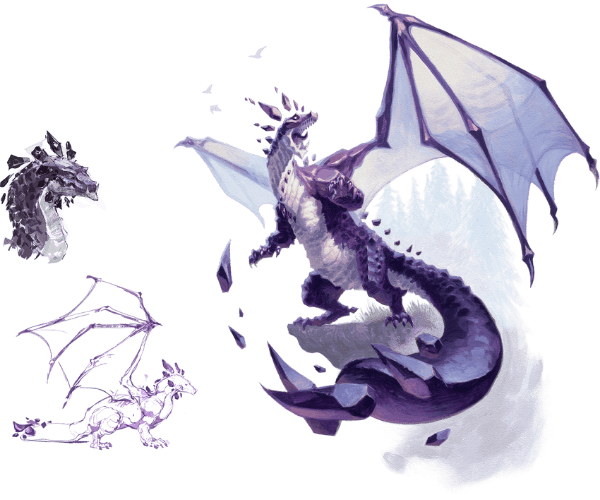
The most powerful of the Gem Dragons, Amethyst Dragons are obsessed with studying and manipulating the fundamental laws that govern reality.
From gravity to time itself, the laws of existence that apply to you or I are mere suggestions to an Amethyst Dragon, whose powers of flight rely as much on its ability to manipulate gravity as they do upon its sweeping wings.
An Amethyst Dragon Wyrmling hatches with dull purple scales. As the creature grows, however, the luster of its crystalline armor grows into a dazzling array of rich purple amethyst crystals, which dance with inner light.
An Amethyst Dragon’s horns are also made from this shimmering purple crystal but, rather than grow out of their heads, they hover behind their skulls, held in the air by telekinetic energies that shift in accordance with their mood.
Amethyst Dragons are deeply concerned with the balance of power between the material plane and those locked in its orbit, especially the Far Realm. As such, they are bitter enemies of mind flayers and other aberrations.
Crystal Dragons
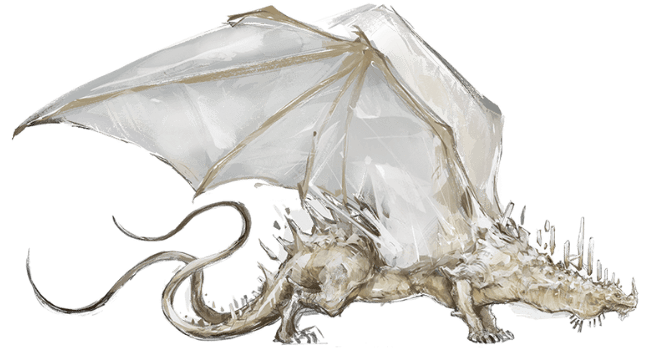
Nurturing, optimistic, and gregarious, Crystal Dragons rival their silver metallic cousins for the title of “Friendliest Dragon”.
Their translucent, shimmering bodies are lit from within by radiant light, and they take great pleasure and interest in reading the stars in the night sky for glimpses of the future.
Despite their warm natures, Crystal Dragons choose to make their homes in frozen, ice-bound places, which often brings them into conflict with frost giants and white dragons.
Crystal Dragons have a tendency to adopt and foster the abandoned eggs of other dragons, and simply resting within a few miles of a Crystal Dragon’s lair is enough to cause you to recover more quickly from your wounds.
Emerald Dragons
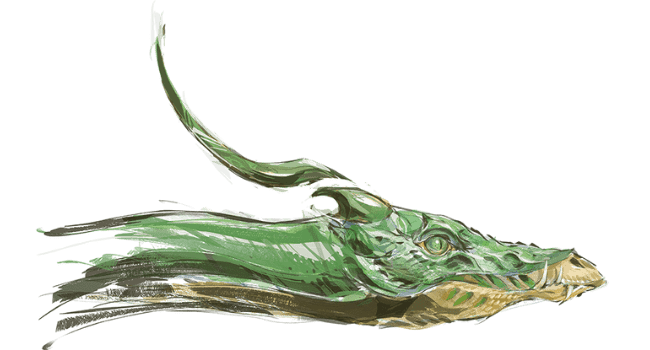
Cunning, manipulative, and possessing a gift for illusory magics, Emerald Dragons actually share some key characteristics with their green chromatic cousins – although their trickery is fueled by their psionic gifts.
They are also the shyest and most curious of the Gem Dragons, prone to cloaking themselves using their psionic abilities and observing humanoid settlements from afar.
Emerald Dragons’ preference for volcanic lairs puts them in frequent conflict with fire giants and red dragons. Emerald Dragons often work with Sapphire Dragons, scouting ahead of their more warlike cousins in order to identify extraplanar threats for destruction.
Sapphire Dragons
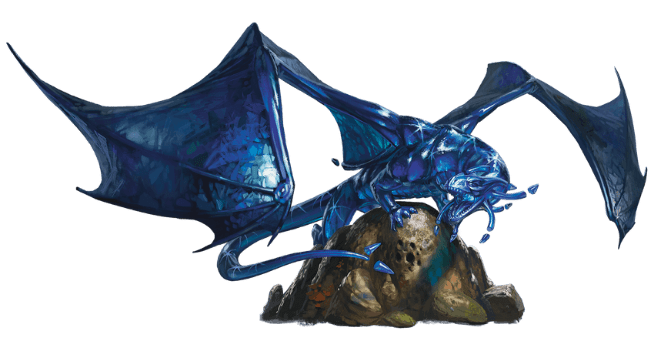
The boldest and most warlike of the Gem Dragons, Sapphire Dragons are perpetually on campaign against one threat or another, swooping down to weaken their foes with a hypersonic shriek, before finishing the job with tooth, claw, and their fearsome array of psionic spells.
Sapphire Dragons are master strategists and use their aptitude for burrowing (a trait which they share with their blue chromatic cousins) to plan ambushes, pincer maneuvers, and to follow their prey unseen.
They are especially devoted to the eradication of extraplanar threats to the material plane, and will often hunt mind flayers, demons, and rogue fey alongside Emerald Dragons.
Their scales are a dizzying and varied array of shades of blue, from delicate eggshell to the crystalline azure of sapphire gems and compressed glacial ice. Their psionic power is made especially obvious by the spines that hover along their head, neck, back, and tail.
Topaz Dragons

Suffused with decay and despair, Topaz Dragons radiate necrotic energy that belies their shimmering golden scales.
Many a luckless adventurer has mistaken a Topaz Dragon for one of its metallic counterparts, only to find themselves on the wrong end of a blast of necrotic energy that melts flesh from bone.
Topaz Dragons are not (usually) malicious, however, viewing the death and destruction they sow as a way of making room for new growth. Forests that wither with their passing soon regrow, rejuvenated and healthier than before.
Topaz Dragons are fascinated with anything entropic; items that both create and destroy can often be found in pride of place in their hoards. They also have a fascination with the undead, and sometimes keep a few locked away as curios within their lairs.
Campaign Advice
Working Gem dragons into your game could be as simple as sending your characters to exotic locations where they live.
However, I think their psionic powers and overall good-to-neutral alignment makes them better candidates for powerful allies or patrons.
Recruiting a Gem Dragon to aid you in the fight against an evil chromatic dragon or some other powerful threat would be the highlight of any campaign I played in.
Deep Dragons
Easily the creepiest entry in Fizban’s Treasury, Deep Dragons are just the splash of nightmare fuel that every good underdark campaign needs.
Native to the underdark, Deep Dragons’ bodies are warped and twisted by centuries dwelling beneath the earth. Their eyes are vast, their heads eel-like, and they play host to colonies of virulent, poisonous fungi.
So attuned are Deep Dragons to their fungal colonies that they can exhale clouds of toxic spores that assault their enemies with nightmarish visions.
What on earth a magic mushroom trip could show me that’s worse than being face to face with a Deep Dragon I’d rather not think about.
Elder Brain Dragon
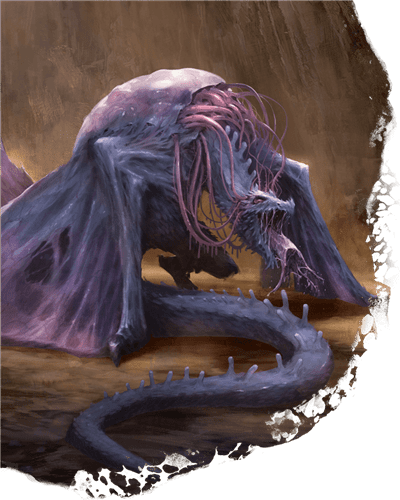
© Wizards of the Coast
Ok, I take it back. This is the creepiest entry in Fizban’s Treasury.
One of the very few limitations of a mind flayer colony is the fact that its elder brain lies trapped with a briny pool at its heart. Should the illithids capture a dragon, however, things immediately get much worse.
The mind flayers carry the captured creature to the elder brain at the heart of their nest, subjecting it to a gruesome transformation.
The elder brain latches onto the dragon’s back, burrowing its tendrils into the creature’s mind and creating this nightmarish result.
The elder brain augments the already fearsome qualities of its draconic host with its own psychic abilities, as well as a grappling tentacle attack and the ability to, ugh, vomit a stream of illithid tadpoles that burrow into your flesh, dealing psychic damage.
If a creature dies while infested with these tadpoles, it becomes a mind flayer. Lovely.
Moonstone Dragons

The Feywild’s answer to shadow dragons, it’s thought that the first Moonstone Dragons were born during the great war between Tiamat, Bahamut, Sardior, and the warlike gods of the outer planes.
A lone dragon found its way into the Feywild and hid her clutch of eggs far away from the war raging back on the material plane.
The energies of the Feywild changed the eggs, creating the first Moonstone Dragons. Graceful, elegant creatures with opalescent scales and ruffs of emerald green fur, Moonstone Dragons are now found throughout the faerie realm.
Moonstone Dragons have the power to project their consciousness into the world of dreams, and their soporific breath attack can send even a raging barbarian into a deep slumber.
Dragon Turtles
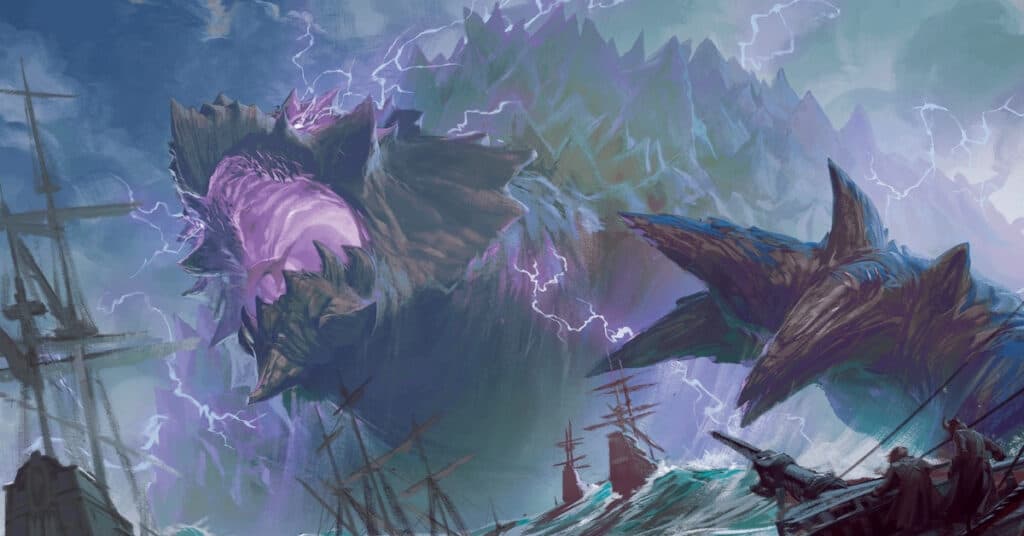
© Wizards of the Coast
These mighty creatures – whose magic stems directly from the oceans of the material plane – have been a part of D&D 5e since the launch of the Monster Manual back in 2014.
However, the original entry only presented an Adult Dragon Turtle. Fizban’s Treasury expands on these magnificent beasts with rules for Dragon Turtle Wyrmlings, Young Dragon Turtles, and even the Avengers-level threat that is the Ancient Dragon Turtle, which the guide notes are comparable in power to a Greatwyrm.
For the most part, you could live your entire life close to (or even on the back of) an Ancient Dragon Turtle and never know.
They’re fond of sleeping for centuries or more, drifting in the ocean currents or paddling lazily along below the surface, enjoying the sun on their backs and paying no mind to the hapless mortals building their homes upon their shells.
When a Dragon Turtle is roused, however, they summon vast tempests that roil across their backs, spew forth scorching gouts of steam powerful enough to shatter the strongest of ships, and boil the oceans around them.
They’re basically D&D Godzilla, is what I’m trying to say.
Greatwyrms
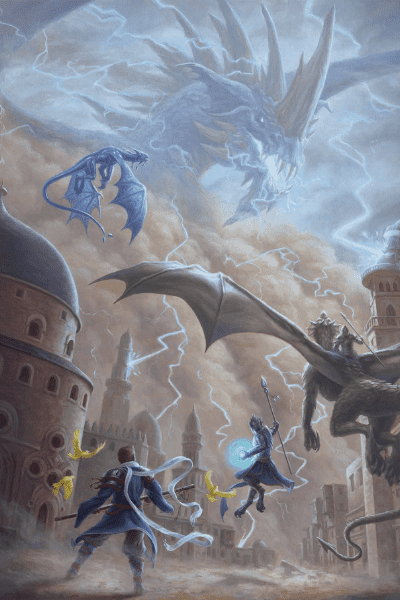
Fizban’s Treasury introduces the concept of Dragonsight, which intertwines with a lot of D&D’s cosmology and theories of planar structure.
In essence, there are many (some might say infinite) material planes, different fractured realities existing at the heart of the planescape, surrounded by all the other realms, from the Plane of Law and the Celestial Plane to The Nine Hells and the Far Realm.
This is how TSR back in the 1980s (ish) justified bringing together D&D’s various campaign settings (the Forgotten Realms, Greyhawk, Dragonlance, Eberron, etc.) into a single semi-cohesive multiverse.
So, say there’s an ancient dragon living in the world of Greyhawk. As it ages, that dragon begins to learn of the existence of its other selves mirrored throughout other planes. Over time, a dragon with Dragonsight learns to observe and even communicate with its other selves.
Sometimes, all those multiple instances of a single dragon find a way to merge their various selves (known as echoes), resulting in the mightiest of all dragons (second only to Bahamut, Tiamat, and Sardior): the Greatwyrm.
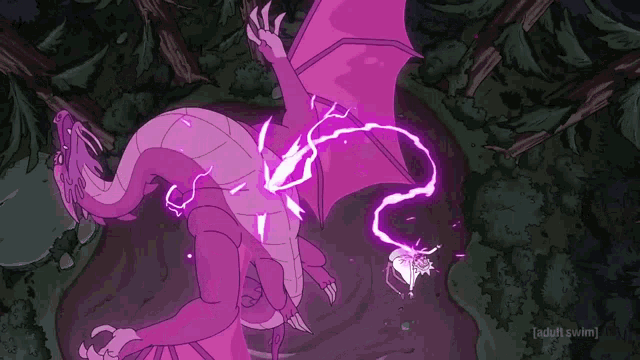
All three types of true dragon can become a Greatwyrm – although Fizban’s Treasury says that Gem Dragons’ innate psionic abilities make them particularly prone to this.
A Metallic Greatwyrm is sometimes aided in its transformation by Bahamut himself, who grants power verging on his own only on his most noble followers.
Chromatic Dragons famously hate one another, and so probably even find the prospect of having to hang out echoes of themselves an intolerable prospect. The black Greatwyrm Chronepsis, for example, stalked multiple worlds and devoured many of his echoes to attain his current form.
Campaign Advice
There’s honestly not a lot that a party of adventurers at any level can do about the appearance of a Greatwyrm. It’s an apocalyptic threat akin to the Tarrasque.
My advice would be to make your campaign about recruiting something big and bad enough to fight the Greatwyrm, like a Tarrasque for example. Or maybe Bahamut himself.
Dragon-Oriented Monsters
In addition to a whole new family of true dragons, variants, and expansion on existing rules for dragons, Fizban’s Treasury of Dragons also brings us a hoard (or horde) of new options for dragon-oriented monsters.
Dragonnels

© Wizards of the Coast
Dragonnels in many respects, look like smaller, sleeker versions of chromatic, metallic, and gem dragons.
However, they are less intelligent (although they’re easily smart enough to understand humanoid language, but not to speak it themselves), only grow to size Large, and don’t possess a breath weapon.
In the wild, Dragonnels are airborne hunters similar to Griffons. They strike from the skies, delivering devastating flyby attacks before landing to finish the job with their razor sharp teeth.
If raised from an egg, however, a Dragonnel makes a powerful flying mount. Loyal to a fault and fearsome on the field of battle, Dragonnels bond for life with a humanoid rider they consider worthy of their companionship.
That’s right, folks. It’s time for a dragon rider campaign.
Draconians

© Wizards of the Coast
When a dragon’s egg is stolen and subjected to the effects of potent sorceries most foul, when it hatches, rather than a single dragon, the egg disgorges several Draconians.
These humanoid dragon folk (though they look like dragonborn or half dragons, Draconians are heavier set and often have wings) are fearsome warriors.
The egg they were hatched from determines their type, which can range from standard footsoldier to the spooky infiltrator, the mage, and the fearsome dreadnought – which can fly, explodes when killed, and can steal the face of anyone it slays.

© Wizards of the Coast
Campaign Advice
I think we may have a contender here for my new favorite monster race. However, Draconians aren’t necessarily evil, but rather have their purpose defined by the mages who created them. They could make excellent guardians of a temple to Bahamut.
But I’d much rather treat them like the Jem’Hadar from Star Trek: Deep Space 9 – a fearsome warrior race created to serve as the iron fist of a tyrannical empire.
Dragonflesh Grafters
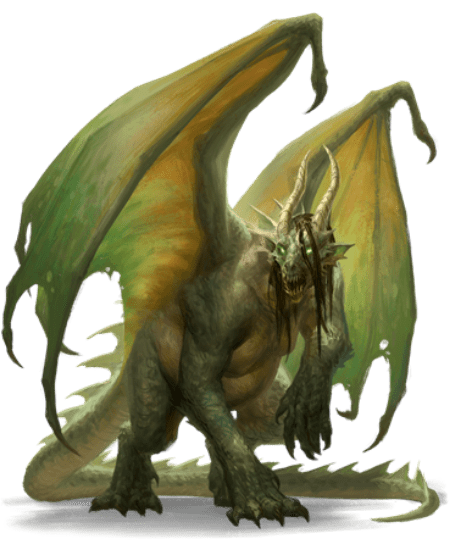
The best way to identify one of these grafters is if you see someone running around chanting, “Look at me! I’m a dragon! I’m a draaaaaagon!” – Fizban
Don’t get me wrong, I like dragons. I don’t like them enough to start sowing bits of them to my body in the hope that I become one. Often members of fanatical death cults devoted to Tiamat, Dragonflesh Grafters are obsessed with transforming themselves into dragons by any means necessary.
They collect dragon parts – scales, teeth, skin, flesh, wings, and bones – from around dragon lairs, from dragon corpses, or from unscrupulous adventurers looking to make a buck.
Then, they either ingest the dragon parts, sow them to their bodies, or implant them in their flesh in the hope of obtaining a measure of the dragon’s power.
A Dragonflesh Grafter mid-transformation is a heinous sight to see (did I mention they also vomit acid?) but the end result is infinitely worse.
In the final stage of a grafter’s transformation, it becomes a hulking monster with an addled brain that craves treasure above all else: a Dragonflesh Abomination.
Dracohydra
Speaking of all the awful things that worshippers of Tiamat get up to in their spare time, meet the Dracohydra.
The result of four sorcerous experiments that attempt to recreate or pay homage to Tiamat’s power, the Dracohydra is what you get when you mix the magic of chromatic dragons (Ok, Fizban, bit vague) with the blood of a hydra.
The resulting monstrosity has multiple heads (not always five), wings, and a prismatic breath attack that combines all the worst qualities of hydra and chromatic dragon.
They’re usually found in the service of the evil spellcasters who created them, bound by arcane wards of subservience. Woe betide any wizard who forgets to charge the magic batteries on their Dracohydra’s shock collar, however.
These gluttonous beasts live for carnage and the subsequent feast.
Campaign Advice
Personally, I could see Tiamat bestowing one as a gift upon a devoted follower – a conniving sorcerer who quickly discovers this white elephant has sowed the seeds of their destruction as it begins to feast upon their minions.
Desperate, the sorcerer unleashes their murderous pet upon a nearby city.
Undead Dragons
Death is only the beginning (Imhotep! … Iieeemmhotepp!!! ahem) for a creature like a dragon, and there are all manner of wonderfully creepy undead dragons and dragon-adjacent monsters dotted throughout Fizban’s Treasury.
Draconic Shard
When a Gem Dragon dies, sometimes its mind refuses to pass on. When this happens, the dragon’s essence lingers in the form of a Draconic Shard, often inhabiting a powerful magic item or other artefact.
A Draconic Shard’s true form is a gigantic spectral dragon. While outside its magic item, the Draconic Shard is a terrifying psionic combatant, capable of crushing the minds of its enemies and commanding total obedience in the weak-minded.
Campaign Advice
The soul of the Gem Dragon inhabiting the shard usually continues to pursue the interests it held in life, although a Gem Dragon choosing to inhabit the magic sword taken from their lair by the adventurers that killed it, continuing to sabotage them at every turn to satisfy its desire for revenge is another possibility that’s totally going in my next campaign.
Dragonbone Golem
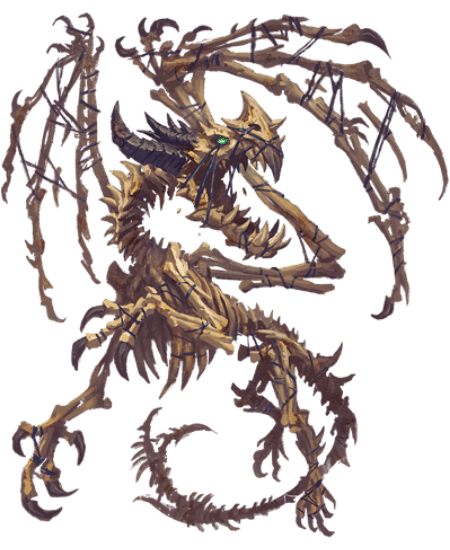
When a powerful dragon vanquishes a rival, sometimes it reanimates the dead dragon’s bones, binding them back together with adamantium wire and arcane glyphs. The result is a Dragonbone Golem, a nightmarish undead typically used to guard its creator’s lair.
In addition to a terrifying bite attack, the Dragonbone Golem can skewer intruders, pinning them to the floor. Its breath weapon inflicts a punishing dose of poison damage that rapidly petrifies those who inhale the fumes.
Ghost Dragon
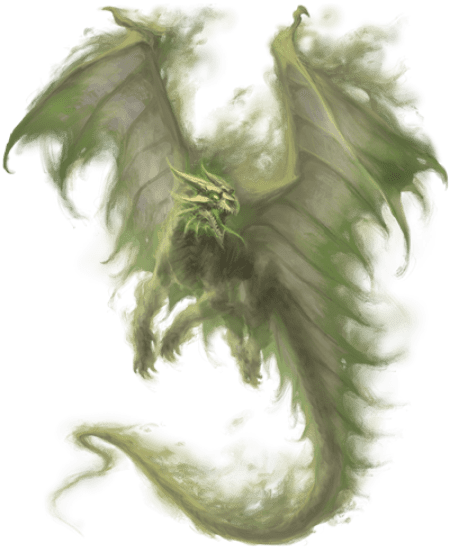
Similar to a Draconic Shard, a Dragon Ghost is formed by the attachment of a dragon to its hoard. When the creature dies, its spirit becomes tied to the treasure it once coveted, resembling a translucent and incorporeal version of the original dragon.
Its ghostly weapon inflicts damage of a type determined by the dragon that died but adds a frighten effect for added terror.
Campaign Advice
If I were running a Ghost Dragon, I would absolutely rule that it could manifest near any item that was once part of its hoard, meaning that the adventure could kick off with a string of bizarre deaths linked to several powerful artifacts recently recovered from a slain dragon’s lair – a paladin, melted to death by acid, still clutching the magical longsword they recovered from the dragon’s hoard; a wizard, clawed to death in a room locked from the inside, surrounded by a ritual of unbinding centered on the magic wand she took from the dragon’s lair.
Recovering every single artifact from a dragon’s hoard in order to break a centuries-old curse has some serious Pirates of the Caribbean vibes, which I love.
Hollow Dragon
Undead dragons aren’t all horrifying monstrosities. Some metallic dragons see death as a chance to pursue a higher, more noble purpose.
For the sake of protecting a powerful artifact or fulfilling some sacred oath, a metallic dragon transforms itself into a Hollow Dragon, waiting in limbo between life and death until the end of time, or its mission is complete – whatever comes first.
A Hollow Dragon takes the form of a metal husk filled with radiant energy. Depending on the dragon’s original type, the energy can appear as flames, lightning, or misty vapors.
Campaign Advice
Ancient dragons (or Greatwyrms) can grow to the size of cathedrals, so a city with the huge, metallic shell of an undead dragon at its center – which is used as a church, housing, or a bustling merchant’s district – could make for a flavorful location, especially if something the adventurers do causes the Hollow Dragon to wake up.
- About Author
- Latest Posts
I played my first tabletop RPG (Pathfinder 1e, specifically) in college. I rocked up late to the first session with an unread rulebook and a human bard called Nick Jugger. It was a rocky start but I had a blast and now, the better part of a decade later, I play, write, and write about tabletop RPGs (mostly 5e, but also PBtA, Forged in the Dark and OSR) games for a living, which is wild.
